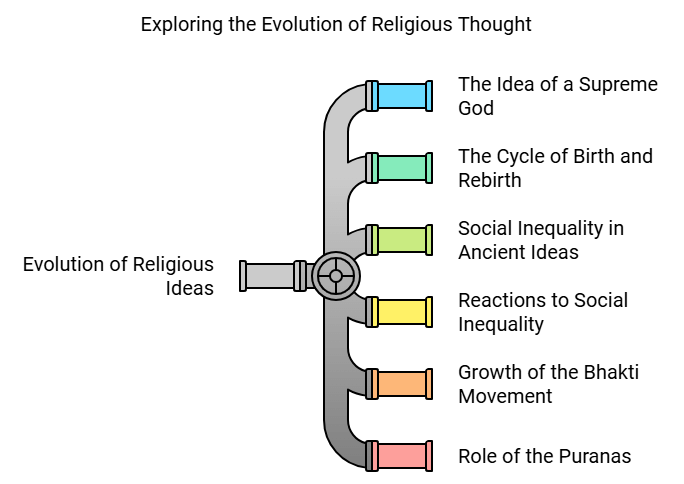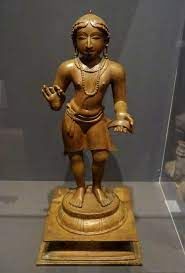Class 7 History Chapter 6 Notes - Devotional Paths to the Divine
Introduction
Throughout history, people have explored various ways to connect with the divine. These paths often involve worship rituals, singing devotional songs like bhajans, kirtans, or qawwalis, and silently repeating the name of God.
For some, this deep connection can be so profound that it brings them to tears. Such intense devotion and love for the divine are rooted in the rich traditions of bhakti and Sufi movements, which have evolved since the eighth century.
The Idea of a Supreme God
Before large kingdoms existed, different groups of people worshipped their own gods and goddesses. As towns, trade, and empires grew, new ideas formed, including beliefs about the cycles of birth and rebirth based on good and bad actions. During this time, the idea that not all humans are equal at birth became common, with many texts discussing social privileges based on noble birth or high caste. Some were drawn to the idea of a Supreme God who could free them from such limitations through devotion (bhakti).
 A page from a South Indian manuscript of the Bhagavad Gita
A page from a South Indian manuscript of the Bhagavad Gita
The Cycle of Birth and Rebirth
- One widely held belief was that all living beings go through cycles of birth, death, and rebirth.
- People thought they accumulated good and bad actions (karma) during these cycles.
Social Inequality in Ancient Ideas
- Another common belief was that not all humans are born equally.
- The idea that social advantages came from being born into a "noble" family or "high" caste was discussed in many scholarly texts.
- This concept was documented in several ancient writings, but not everyone accepted it.
Reactions to Social Inequality
- Some individuals turned to the teachings of Buddha and Jainas, who believed that personal effort could transcend social disparities and the cycle of rebirth.
- Others were drawn to the notion of a Supreme God who could liberate humans from such constraints if approached with devotion (or bhakti).

Growth of the Bhakti Movement
- The concept of bhakti is found in the Bhagavad Gita, a revered text among Hindus.
- It gained popularity during the early centuries of the Common Era.
- Worship of deities like Shiva, Vishnu, and Durga became essential to later Hinduism, accompanied by rituals and narratives linked to them. This worship through bhakti became very popular at this time.
Role of the Puranas
- Local myths and legends were woven into the narratives of these deities.
- The Puranas (sacred texts) outlined worship practices that became part of local customs.
- The Puranas also highlighted that anyone, regardless of caste, could attain God's grace through devotion.
- They asserted that devotees could receive God's grace irrespective of their caste background.
Influence of Bhakti on Other Religions
- The idea of bhakti became so influential that even Buddhists and Jainas started to adopt similar beliefs, blending them with their own teachings.
A New Kind of Bhakti in South India - Nayanars and Alvars
The seventh to ninth centuries saw the emergence of a new religious movement led by Nayanars (saints devoted to Shiva) and Alvars (saints devoted to Vishnu). These saints promoted passionate devotion to Shiva or Vishnu as the path to salvation.

Criticism of Other Religions
- The Nayanars and Alvars strongly criticised the Buddhists and Jainas.
- They highlighted personal love and devotion to their deities as the genuine route to spiritual freedom.
Traveling Poets and Devotional Songs
- Nayanars and Alvars journeyed from village to village, writing beautiful poems to praise the deities worshipped there.
- These poems were set to music, fostering a deep connection between poetry, music, and devotion.
Strengthening Bhakti and Temple Worship
- Between the tenth and twelfth centuries, the Chola and Pandya kings constructed impressive temples at the shrines visited by these saints.
- This further solidified the bond between bhakti traditions and temple worship.
Compilation of Poems and Biographies
- The poems composed by the Nayanars and Alvars were later compiled into sacred collections.
- Hagiographies (religious biographies) of these saints were also written during this time, helping preserve their legacy.

Nayanars: Devotees of Shiva
- The Nayanars were a group of 63 individuals from various social backgrounds, including potters, 'untouchable' workers, peasants, hunters, soldiers, Brahmanas, and chiefs. They represented all castes, including those viewed as 'untouchable' like the Pulaiyar and Panars.
- Notable Nayanars included Appar, Sambandar, Sundarar, and Manikkavasagar. They were openly critical of Buddhists and Jainas, promoting the love of Shiva as a means to achieve salvation.
- Their devotional songs were collected in two main works: Tevaram and Tiruvacakam.
 A bronze image of Manikkavasagar
A bronze image of Manikkavasagar
Alvars: Devotees of Vishnu
- There were 12 Alvars, each coming from different backgrounds.
- Notable Alvars include Periyalvar, his daughter Andal, Tondaradippodi Alvar, and Nammalvar.
- They were very critical of Buddhists and Jainas, promoting a deep love for Shiva or Vishnu as the way to salvation.
- The Alvars combined ideals of love and heroism from Sangam literature with bhakti values.
- Their hymns were gathered in a collection called Divya Prabandham.

Philosophy and Bhakti
Advaita Vedanta: Shankara’s Teachings
- Shankara was a prominent Indian philosopher born in Kerala during the eighth century.
- He supported Advaita, which teaches that the individual soul (Atman) and the Supreme God (Brahman) are one, with Brahman being the ultimate reality without form or attributes.
- Shankara viewed the material world as an illusion, known as maya, and encouraged people to renounce worldly attachments, focusing on knowledge to understand Brahman and achieve salvation.
 Advaita Vedanta
Advaita Vedanta
Ramanuja and Vishishtadvaita
- Ramanuja was born in Tamil Nadu during the eleventh century and was significantly influenced by the Alvars, who were devoted to Vishnu.
- He presented the idea of Vishishtadvaita, or qualified oneness, which asserts that while the soul is united with the Supreme God, it remains distinct. He believed that intense devotion to Vishnu was the best way to attain salvation, as Vishnu’s grace leads to a joyful union with Him.
- Ramanuja's teachings inspired a new form of bhakti that later developed in northern India.

Basavanna’s Virashaivism
In the mid-twelfth century, a new religious movement called Virashaivism arose in Karnataka. This movement was led by prominent figures such as Basavanna, Allama Prabhu, and Akkamahadevi.
Core Beliefs of Virashaivism
- Equality for All: The Virashaivas strongly believed in the equality of all people, opposing traditional Brahmanical views on caste and the treatment of women.
- Rejection of Rituals: They opposed all types of rituals and idol worship, instead focusing on values of equality.
- Challenging Discrimination: The movement aimed to counter existing beliefs, advocating that everyone should be treated equally, regardless of caste or gender.
Bhakti Movement in the Deccan
Between the 13th and 17th centuries, Maharashtra saw the rise of several saint-poets, including Janeshwar, Namdev, Eknath, and Tukaram. Notable women saints included Sakkubai and members of Chokhamela’s family from the "untouchable" Mahar caste. This local bhakti tradition centred around the Vitthala temple in Pandharpur and the idea of a personal god living in everyone’s heart.
 Vitthal Rukmini Mandir
Vitthal Rukmini Mandir
Teachings and Lifestyle
- Devotional Verses: The saints wrote devotional poems in simple Marathi, focusing on Lord Vitthala in Pandharpur.
- Rejection of Ritualism: They turned away from ritual practices, public displays of faith, and social hierarchies based on birth.
- Compassion and Engagement: Their bhakti teachings highlighted a personal bond with God, emphasising empathy for others' suffering. They believed that true Vaishnavas are those who feel and share in the pain of others.
- Varkari Sect: The devotion to Lord Vitthala led to the formation of the Varkari sect, which promotes a yearly pilgrimage to Pandharpur.
- Cult of Vitthala: The cult of Vitthala became a significant form of devotion and gained immense popularity among the people.
- Contribution to Music: The Bhakti saints played a key role in music development, especially through bhajan, kirtan, and abhang.
Nathpanthis, Siddhas, and Yogis
Several religious groups that came about during this time opposed traditional rituals and the social structure, using straightforward and logical reasoning. Among these were the Nathpanthis, Siddhacharas, and Yogis.
 A fireside gathering of ascetics
A fireside gathering of ascetics
Beliefs and Practices
- They believed in renouncing worldly possessions and focusing on deep meditation to achieve inner peace.
- Their practice involved meditating on a powerful force to feel a connection and find tranquility.
- They also emphasized the importance of training both the mind and body through activities like yogasanas (yoga poses).
Appeal to Lower Castes
- Many people from lower castes were drawn to these new ideas because they offered an alternative to traditional religious practices.
- By challenging established norms, these groups played a key role in shaping a new form of religion that became influential in northern India.
Islam and Sufism
Influence and Beliefs
- Shared Ideas: Sants, or saints, and Sufis, who were Muslim mystics, exchanged many ideas and likely influenced each other. Their critiques of traditional religion helped devotional practices gain popularity in northern India.
- Sufi Beliefs: Sufis focused on love and devotion towards God and compassion for all people, aiming for a deep, personal relationship with God, akin to a lover's connection. They added a new dimension to Islam that prioritised personal devotion.
- Islamic Practices: Islam advocated for strict monotheism, rejected idol worship, and streamlined rituals into communal prayers. The Shariat, or holy law, was established to guide these practices.
- Sufi Practices: Sufis created detailed training methods, including zikr (chanting of a name or sacred phrase), contemplation, sama (singing), raqs (dancing), storytelling, and breath control under a teacher's guidance.
 Islam and Sufism
Islam and Sufism
Sufi Influence and Presence
- Central Asia to Hindustan: Numerous Sufis from Central Asia migrated to the Indian subcontinent (Hindustan) starting in the eleventh century, particularly during the rise of the Delhi Sultanate.
- Chishti Order: The Chishti order was a significant Sufi group with renowned teachers like Khwaja Muinuddin Chishti, Qutbuddin Bakhtiar Kaki, Baba Farid, Khwaja Nizamuddin Auliya, and Bandanawaz Gisudaraz. Notable Sufis from Central Asia included Ghazzali, Rumi, and Sadi.
- Khanqahs: Sufi masters hosted gatherings in hospices called khanqahs, where individuals from all backgrounds, including royalty, came together to discuss spiritual topics, seek blessings, and enjoy music and dance.
Sufi Mysticism
- Miraculous Powers: Sufi masters were often thought to possess miraculous abilities that could alleviate others' ailments and dilemmas, making their tombs, or dargahs, popular pilgrimage sites for people of various faiths.
 Mystics in ecstasy
Mystics in ecstasy
- Literary Contributions: Sufis, like the saint-poets, wrote poems to express their emotions, leading to the growth of rich literature in prose, including stories and fables about them.
- Spiritual Training: Sufis believed in training the heart to see the world in a new way, following various lineages (silsilas) that had different methods for spiritual training and rituals.
New Religious Developments in North India
After the 13th century, a fresh wave of the bhakti movement emerged in north India, shaped by influences from Islam, traditional Hinduism, Sufism, various bhakti traditions, and groups like Nathpanths, Siddhas, and Yogis. This period saw the rise of new kingdoms and the emergence of new roles for people.
- During this time, new towns and kingdoms were emerging, and people were taking up different professions. Craftspersons, peasants, traders, and laborers were particularly interested in the teachings of the saints.
 Tulsidas and Surdas
Tulsidas and Surdas - Saints like Kabir and Baba Guru Nanak rejected orthodox religions, while others like Tulsidas and Surdas accepted existing beliefs but aimed to make them accessible to everyone.
- Tulsidas viewed God in the form of Rama and wrote the Ramcharitmanas in Awadhi, expressing his devotion and creating a significant literary work.
- Surdas, an ardent devotee of Krishna, composed devotional songs compiled in the Sursagara, Surasaravali, and Sahitya Lahari.
 Sahitya Lahari
Sahitya Lahari - Shankaradeva emphasized devotion to Vishnu and started the tradition of namghars or houses of recitation and prayer in Assam.
- Dadu Dayal, Ravidas, and Mirabai were also part of this tradition. Mirabai, a Rajput princess, defied norms by becoming a disciple of Ravidas and composing bhajans expressing her intense devotion to Krishna.
- A unique feature was that most saints composed their works in regional languages that could be sung. These songs, transmitted orally, became immensely popular, especially among the poorest and most deprived communities and women. The songs evolved as generations added their own experiences, becoming an integral part of living popular culture.
A Closer Look: Kabir
Kabir, an influential saint who lived around the 15th-16th centuries, came from a Muslim weaver family near Benares (Varanasi).
 Sant Kabir
Sant Kabir
- We have little reliable information about Kabir's life; his ideas come from verses called sakhis and pads, sung by wandering bhajan singers. Some were later collected in texts like Guru Granth Sahib, Panch Vani, and Bijak.
- Kabir strongly rejected major religious traditions, openly ridiculing external worship in Brahmanical Hinduism and Islam, as well as the priestly classes and caste system.
- His poetry was written in a form of spoken Hindi that was widely understood by the common people. Occasionally, he used cryptic language, making his teachings somewhat difficult to grasp.
- Kabir believed in a formless Supreme God and taught that the only way to achieve salvation was through bhakti (devotion).
- He attracted followers from both Hindu and Muslim communities.
A Closer Look: Baba Guru Nanak
Baba Guru Nanak (1469-1539) was born in Talwandi (Nankana Sahib, Pakistan) and travelled widely before starting a centre at Kartarpur (Dera Baba Nanak on the river Ravi).
 Guru Nanak Dev ji
Guru Nanak Dev ji
- A regular worship service featuring the singing of his own hymns was set up there for his followers. Regardless of their previous beliefs, caste, or gender, his followers shared meals together in the common kitchen, known as langar.
- The sacred space created by Baba Guru Nanak was called dharmsal, which is now referred to as Gurdwara.
Succession and Compilation
- Before his death in 1539, Baba Guru Nanak appointed Lehna, who became known as Guru Angad, as his successor.
- Guru Angad collected the works of Baba Guru Nanak, added his own, and developed a new script called Gurmukhi.
- The three successors of Guru Angad wrote under the name "Nanak," and all their writings were gathered by Guru Arjan in 1604.

- This collection also featured contributions from other notable figures such as Shaikh Farid, Sant Kabir, Bhagat Namdev, and Guru Tegh Bahadur.
- In 1706, Guru Gobind Singh, the son and successor of Guru Tegh Bahadur, confirmed this compilation, which is now called Guru Granth Sahib, the holy scripture of the Sikhs.
Expansion of Followers and Political Development
- The historical changes in the sixteenth and seventeenth centuries played a key role in shaping the Sikh movement.
- Baba Guru Nanak's teachings greatly influenced this movement right from its inception. He highlighted the significance of worshipping one God and stated that caste, gender, or creed did not matter for achieving liberation.
- During the sixteenth century, Baba Guru Nanak's followers grew under his successors, mainly comprising traders, farmers, artisans, and craftsmen. This growth is likely linked to his call for followers to be family-oriented, work in productive jobs, and support the community.

- Amritsar emerged around the main Gurdwara, the Harmandar Sahib (Golden Temple). By the early seventeenth century, Ramdaspur (Amritsar) had developed around this Gurdwara, becoming almost self-governing.
- Mughal Emperor Jahangir perceived the Sikhs as a potential threat, leading to the execution of Guru Arjan in 1606.
- The Sikh movement became more political in the seventeenth century, culminating in the establishment of the Khalsa by Guru Gobind Singh in 1699, forming the Khalsa Panth as a political group.
Baba Guru Nanak's Teachings
- Baba Guru Nanak's teachings significantly shaped the Sikh movement, promoting the worship of one God while rejecting differences based on caste, creed, and gender to achieve liberation.
- He encouraged an engaged life marked by social responsibility, highlighting the importance of right worship, helping others, and maintaining purity in behaviour. For him, liberation was about living actively with a strong commitment to society.
- His core teachings are remembered as nam (right worship), dan (helping others), and isnan (purity of conduct).
- Baba Guru Nanak's vision of equality had significant social and political effects, setting his followers apart from other religious leaders like Kabir, Ravidas, and Dadu, even though they shared similar thoughts.
- Guru Angad collected and compiled the writings of Baba Guru Nanak, adding his contributions in a new script called Gurmukhi.
Important Dates
- 1469-1539 – The period of Baba Guru Nanak.
- 1539 – Baba Guru Nanak died.
- 1604 – Guru Arjan compiled all the compositions written by the three successors of Guru Angad.
- 1606 – Guru Arjan was executed.
- 1699 – The Khalsa was instituted by Guru Gobind Singh.
|
63 videos|371 docs|46 tests
|
FAQs on Class 7 History Chapter 6 Notes - Devotional Paths to the Divine
| 1. What is the significance of Bhakti in the context of Nayanars and Alvars in South India? |  |
| 2. How did Basavanna contribute to the development of Virashaivism? |  |
| 3. What role did Sufism play in the context of Islam in India? |  |
| 4. Who was Kabir, and what was his contribution to the Bhakti movement? |  |
| 5. How did Baba Guru Nanak influence Sikhism and its teachings? |  |
























